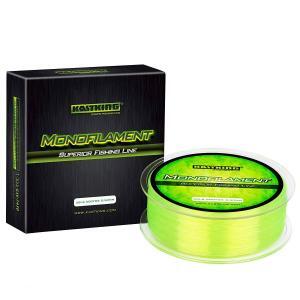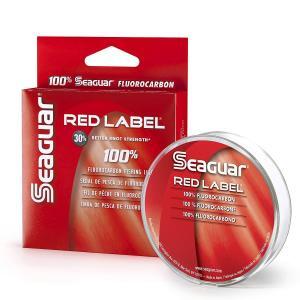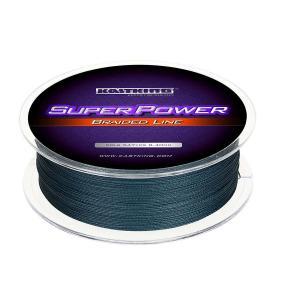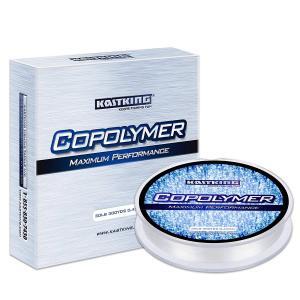There are different types of fishing line and you should use them all. You know selecting the right line is a lot like selecting the right tool. So I like to think about the application first and then I pick the right type of fishing line. So let’s look at all types of line. We cover in this article all types of fishing line.
All Types Of Fishing Line With Buying Guideline
-
Monofilament
-
Fluorocarbon
-
Braid
-
Copolymer or Hybrid
Monofilament line
Mono is a high floating tends to float more. So when I want to keep a bait high a topwater, awake bait, if I want to keep a lure up in the water column, a lot of times I’ll go to mono. The other thing is to help in delay. A lot of times when fish are missing crankbaits it’s because you’re trying to hook them too fast when you feel them. By going to mono, mono is really stretchy, it’s got a lot of stretch to it. You’re actually gonna slow your hook set down, you’re gonna slow your delay down, so I love mono for top waters and some situations in cranking. I still love mono.
Pros
- -cheap
- -abrasion resistance
- -stretchy
- -floats
- -good knot strength
- -low visibility
Cons
- -retains memory
- -thicker
- -UV damage effect
- -low sensitive for the stretch
- -a lot of memory so gets line twist often
- -thick -so affected by wind – can’t cast so far -reduce reel line capacity
Fluorocarbon line
Fluorocarbon is invisible. Fluorocarbon got a little less stretch than mono. It’s abrasion resistant but the great thing and the property I love about fluorocarbon is it’s dense and a dense line actually sinks in the water. Unlike mono that flows but fluorocarbon sinks. So for techniques where you want to get the bait to stay down or go deeper, fluorocarbon a great choice. A lot of my finesse fishing, a lot of my swimbait fishing or deep crankbait fishing where I want to get that bait to go down and stay down it’s done with fluorocarbon.
Pros
- -invisible underwater
- -best for clear water
- – sink so good
- -abrasion resistance
- -little stretch
- -thinner than mono
- -more UV light resistant than mono
Cons
- Expensive
- Line memory
Braid line
Braid line got zero stretches. So mono had a lot, fluorocarbon had a little and braid has none. No stretch whatsoever. It’s very abrasion resistant and it’s got a really small diameter for the strength of the line. So in situations where I have to make a super long cast I love braid line. Either tie directly to the bait or to a fluorocarbon leader in super deep water. Water that’s deeper than say 30-40 foot deep, I love braid. Because it eliminates the strength in that real deep water on the hook set and then finally of course In extreme heavy cover situations when you’re fishing the nastiest cover ever. So I love a braided line because zero stretch and they’ll get those big fish out of that heavy cover. Braid Line Is Great for Bass And I write an Article about Best Line For Bass.
Pros
- -small diameter
- -maximum casting distance
- – bite sensitive
- -no line memory
- -very thin
- -UV light resistant
Cons
- -more visible
- -expensive
- -no stretch
The copolymer or Hybrid Line
The copolymer is a combination of monofilament and fluorocarbon. What it is mean, a monofilament core that’s been coated with fluorocarbon. It’s got less stretch than monofilament and a little bit more stretch than fluorocarbon. It’s got great abrasion resistance. It ties knots easily. It’s very low memory. Thinner than mono and fluorocarbon so good for casting also. It’s best for small diameter line. Work best like the 4-pound test, 6-pound test, and 8-pound test. I just rarely use it for anything bigger than ten pounds. It works really good on ultra-light rods when you’re finesses fishing. It’s cast super far and it’s really strong.
Pros
- -Balanced stretch
- -good casting ability
- -great abrasion resistant
- -less memory
- -best for small diameters trout & bass.
Cons
- Expensive
This is a great informative video for all types of fishing line.
FISHING LINE SELECTION METHOD
So for making your purchase comfortable or removing your confusion about selecting your preferable fishing line, I give you this research sheet so that you can choose what line is best for your particular fishing types.
Species
What species of fish are you going to be targeting? Now, this is gonna play role in your line sighs, so what pound test it is. If you’re fishing for crappie or bluegill you’re probably not going to use a fourty pound test line. You there’s no need for it. You’re probably going to be using something in the four to six-pound test range and you’re probably gonna want something that is going to get that little tiny jig head if you’re using the jig down in the water a little bit quicker. Now if you’re fishing for bass there are all sorts of options for a line. You know whether it’s braid for certain application, fluorocarbon for certain application and monofilament for certain. Now if you’re fishing for trout you’re probably not going to use a braided fishing line. You might use a braid as a backing and then some fluorocarbon line as a leader just to save the cast of spooling up a whole reel with fluorocarbon. Officially trout are often really picky and they will often follow a lure or inspect a lure for quite a while before they commit to striking. A lot of trout can often be line shy so you are gonna want to pay attention to that and you’re probably going to want to use a diameter of the line, that’s not going to be really visible in the water. If you’re fishing for redfish or black drum or Hatteras blue you know on the east coast and the intercostal waterways. You’re probably gonna want a thicker line those fish are strong fish you know in some cases those fish have teeth , that you need to contend with so you need to be considerate of those species that you’re targeting, how they approach the lure, how they make a decision , whether or not the strike and also some of their features like teeth and their strength.
Water
So the second thing you need to consider is the water you’re fishing in. if you are fishing in really muddy water odds are fish aren’t gonna have the opportunity sometimes to really inspect the bait they’re gonna be more reactionary, so using a braided line in a muddy water or a thicker line in muddy water isn’t gonna be as big of a deal as opposed to using a thicker line or braided line in gin-clear water, say you’re fishing for bass and a gin-clear lake you might need to go to a 6 pound test line and you might not be totally comfortable with that you might be worried that line will break. Now that’s the situation where you really need to take into consideration the drag on your reel. The function of the Drag on your reel is to allow the fish to move, allow the fish to run just enough that it’s not going to break your line. You might have to work that fish a little bit which will make for an exciting fight. But you might have to work it a little bit if you’re using a smaller test line but it should pay dividends and more bites. If you’re fishing really crystal clear or gin-clear water using a line size that’s smaller so that is a consideration as well. If you’re fishing in a waterway that has a current and you need to get a bait down in the current, you’re gonna want to use something that sinks monofilament. It really doesn’t sink too much. So fluorocarbon line in my case the fluoro coat it actually sinks case so it’s gonna help assist your lure. Your bait or whatever get down into the strike zone a little bit faster in a moving current so that’s something to consider as well.
Line stretch
The next thing we need to consider is stretch versus no stretch. Some lines like a monofilament they have some stretch in them in the line itself and that’s actually a good characteristic to have in some situations. Now often lines have less stretch, fluorocarbon has less stretch, braided has almost zero stretch and that is something you want in certain situations as well you just in some situation. You don’t want your line to stretch if you’re fishing a frog on topwater. You typically want to use braid, you don’t want to use monofilament in this situation and you don’t want a lot of stretches and the primary reason for that is so you can get a good hook set when that fish takes it. So the fish slams your frog takes it under you wait for a second rule up any slack and then boom. You want to set that hook and you don’t want a bunch of stretches, you want to drive that hook through the mouth or the lip or whatever of that fish of that bass situations. Where you do want some stretch our situations where you’re fishing like a treble hook or you’re fishing for a species that has maybe a soft flush mouth doesn’t have a lot of bone in there you want that to stretch a little bit, so that when you set that hook it doesn’t tear out of the fish’s mouth. Situations like fishing a crankbait, crankbaits nine times out of ten well 99% of the time. If I am fishing a crankbait I am going to be using a monofilament line because when that’s fish hits a lot of times it’ll strike from the side. You don’t want to just rip that right out of the mouth. Another situation when I typically use a monofilament line because of its stretch. So using like a spook or something like that on the top water again those have trouble hooks you don’t want to rip that out of the mouth and for me personally, it also seems a little bit easier to walk the rod with the line that has some stretch. In it, jerk baits are also a little bit easier for me. With monofilament, I feel like I get a little bit better action with a line that does have some stretch to it.
The environment of the fishing place
If you are fishing in an area that has a lot of sharp, rocky, ledges or terrain or you’re fishing in an area that has like zebra mussels or oyster beds or something like that you’re gonna want a line that’s abrasion resistant.
Fluorocarbon tends to kind of shine in this area. It’s a pretty hard material actually so it has a little bit more abrasion resistance than a mono. Well now if you’re fishing really heavy cover like if you’re punching a map or flipping Tooley’s something like that for bass.
You’re probably gonna want to go with a braided line where I fish I typically fish with a 65-pound braid any time that I am gonna be punching something. If I am flipping I will often flip with a 65-pound braid as well, just because I want to know that if I get a fish on and it is in the weeds like choked in the weeds. It’s not gonna come off due to a line failure or a not failure as long as I got a good hook set that fish is gonna come off when I grab it and take the hook out. A braided line, in general, is going to be great for punching and flipping and those types of applications where you’re actually in the cover.
So when you’re trying to pick a line think about what you are doing. Thinking about the line as a tool and pick the right line for the right situation and you’re gonna land more fish. I also write an article about the fishing rod, you can check it here. Want to know more about the fishing line then check it





